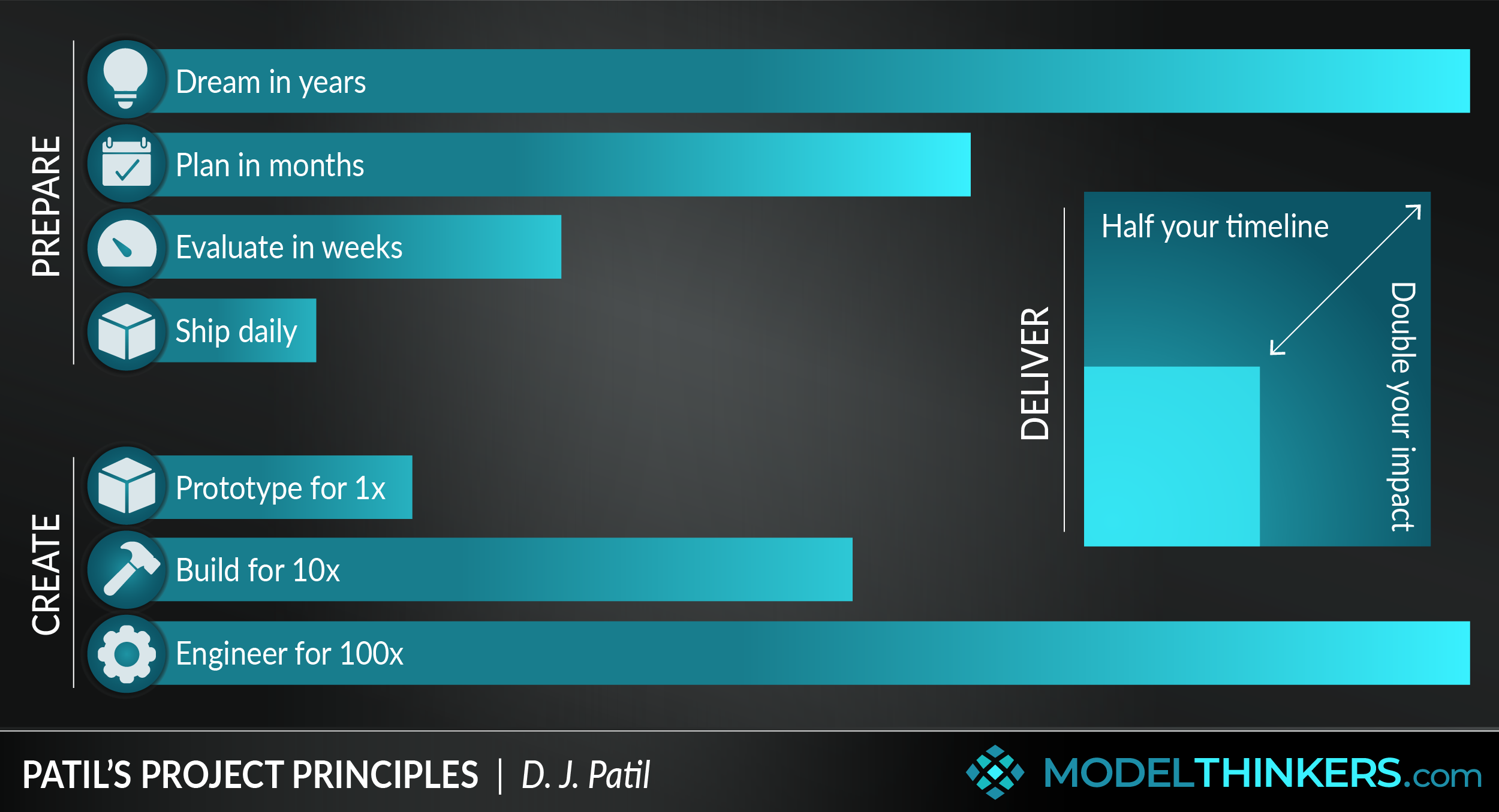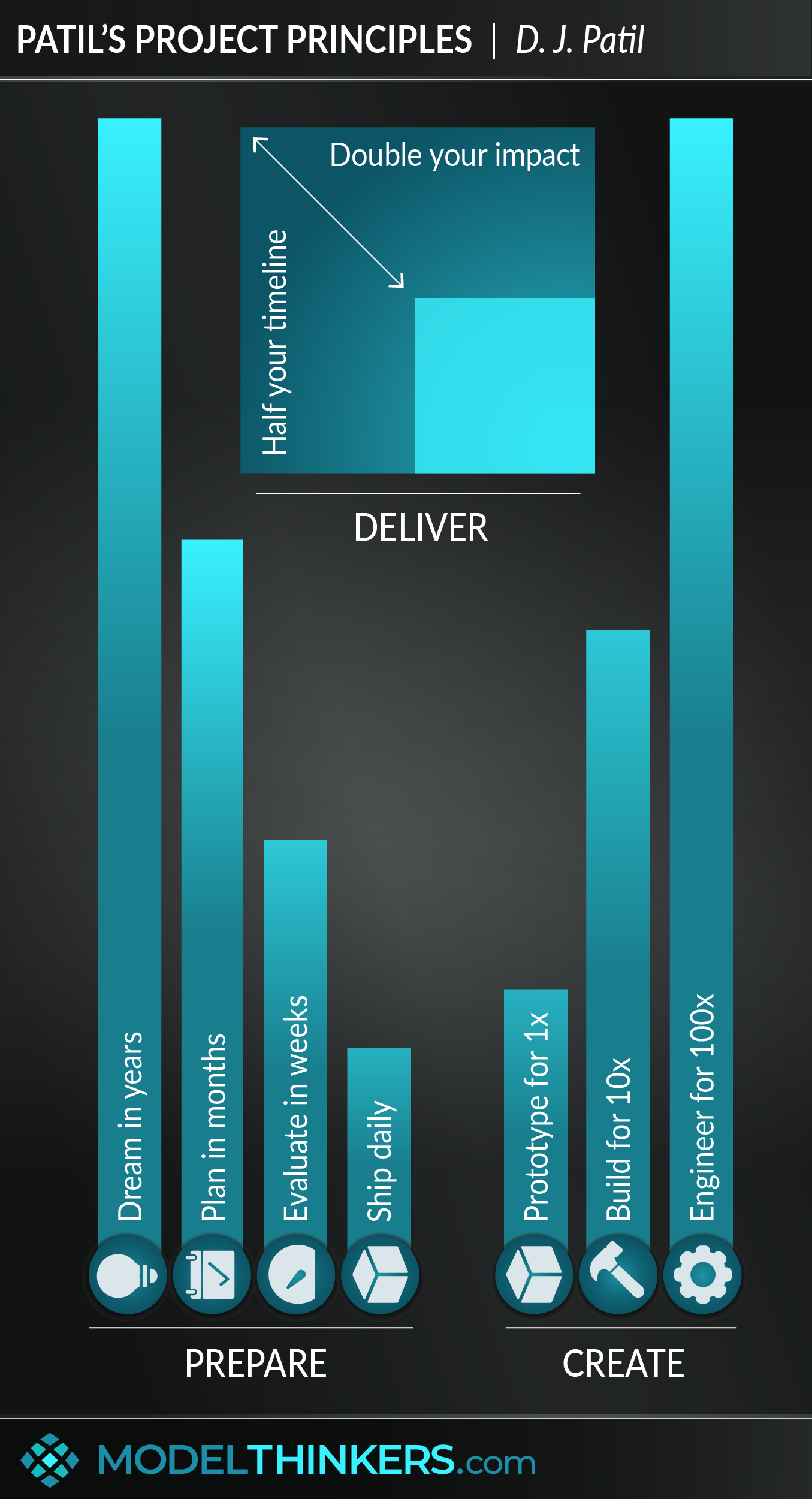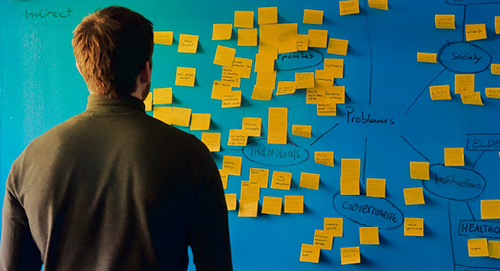

 0 saved
0 saved
 18.9K views
18.9K views








As the first-ever US Chief Data Scientist appointed to Obama’s White House, D.J. Patil faced high expectations and considerable challenges. One of the tools he used throughout that time was a simple handwritten note to himself.
Patil’s note was a reminder to:
-
Dream in years; plan in months; evaluate in weeks; ship daily.
-
Prototype for 1x ; build for 10x; engineer for 100x.
-
Find what’s required to cut the timeline in half; what needs to be done to double the impact.
THE NOTE.
The note was released publicly in 2015 (see the Origins & Resources below for a screenshot) and became a popular poster in 2019. When talking about the note, Patil explained: “I kept it in my notebook because it was a daily reminder of what was needed to do my job: to make the country a bit better each day.
“Ship daily means that we ‘deliver’ something each day. Yet, we stay focused on vision and never forget to dream big.
“We should always go asleep at night knowing that we delivered something. Some days it will be something small, other days, it will be something big. But, always create something.
“Prototype for 1x means that we need to try lots of ideas. Some will work, most won’t. That’s ok, we’re trying to test ideas and iterate fast to figure out what the right solutions are. Build for 10x is the next step once we’ve figured out what works. Our goal is to start scaling the idea to reach ten times the impact. And once we’ve figured out how to do that, we can move on to engineering the approach to 100 times the impact."
Finally, Patil explains the last section: “This is about the need to go fast and ensure that we’re working on the highest priority items that deliver the greatest impact.”
IN YOUR LATTICEWORK.
These principles can be applied as a checklist and a high-level guide for a diverse range of projects. They share much with Agile Methodology and Lean Thinking, as well as other prioritisation models such as the Pareto Principle.




-
Iterate fast, plan big.
The first section of Patil’s principles suggests constant and daily iteration (shipping) while taking the time to step back and consider the big picture dreams and outcomes.
-
Experiment and engineer to scale.
Patil recommends constant experimentation, with an eye to how such tests might be incrementally scaled for mass production.
-
Focus on the highest value and cut waste.
In call outs to both the Pareto Principle and Lean Thinking, Patil’s final point is about focusing on the high priority work for the greatest value.
The high level nature of Patil’s project principles defy intense scrutiny. Most will agree with these principles and, to be fair, Patil did not create them as a detailed manifesto. The devil will really be in the detail — that is how will you apply and use these principles.
The aftermath of Michael Brown’s death.
In this commencement speech, D.J. Patil describes that the drive for his note came after the 2014 killing of Michael Brown in Ferguson. Brown, an 18 year old black man, was fatally shot by a white police officer.
The aftermath saw growing civil unrest and protests. The Obama administration brought together police chiefs, technologists and activists to spend a day to identify actionable solutions. Patil explains: “As people made their way through security to the large room we were meeting in, groups formed. Uniforms huddled in one corner, suits in another, and of course, hoodies in another. And, you could feel the tension between groups. The mistrust was palpable. No eye contact, everyone was stiff, and there certainly wasn’t any mixing of the groups taking place.
“It was my job to get them aligned to work on a set of solutions. And I was nervous. This was a fresh wound for the country, and I still hadn’t figured out what to say. So I sat in a corner and asked myself what would it take to “ship something today”? Something we could all align around. My hope was that if we just all rolled up our sleeves and got to work, something positive might happen. We just needed some guiding principles of how we build. How we build ‘together’.
“Now, here’s the amazing thing that happened when I got to the lectern. When I told them our goal is to ‘ship something today’, the body language changed. Some were nervous, others were engaged, but the tension was gone. After all, there’s nothing like telling a group that President Obama is going to want to know what we shipped today in exchange for using one of his largest conference rooms.”
Patil explains that this process helped lay the foundation for the Police Data Initiative and the Data-Driven Justice Initiative to help provide greater transparency and ‘open up’ data to the public.
Patil’s project principles are high level approaches that can be applied broadly.
Use the following examples of connected and complementary models to weave Patil’s project principles into your broader latticework of mental models. Alternatively, discover your own connections by exploring the category list above.
Connected models:
-
Lean thinking and lean startup: both models align closely with the idea of fast shipping for greater value and reducing waste.
-
Agile methodology: for quick iterations.
-
Prototypes and feedback loops: in testing and experimenting.
-
Compounding: for the idea of marginal continuous gains.
-
Pareto principle: to identify high value and potential waste areas.
Complementary models:
-
Eisenhower matrix: use in combination with this priority task list.
-
Golden circle: find the intersection between values driven work and this highly effective approach.
-
Psychological safety: add this to your toolkit for highly successful teams.
As described, this note was created and used by D.J. Patil, the first US Chief Data Officer, during his time in the Obama Whitehouse.
There were several versions of this note which were released as photos in 2015. An artist named Shirt approached Patil about sharing the note as a poster in 2019 as a charity initiative. Patil agreed and the poster helped popularise the approach as a result.
Find out more about D.J. Patil from his commencement address, where he discusses the note, and follow Patil on Twitter here.
This note and other cards from his time at the White House are available here.
 My Notes
My Notes
Oops, That’s Members’ Only!
Fortunately, it only costs US$5/month to Join ModelThinkers and access everything so that you can rapidly discover, learn, and apply the world’s most powerful ideas.
ModelThinkers membership at a glance:






“Yeah, we hate pop ups too. But we wanted to let you know that, with ModelThinkers, we’re making it easier for you to adapt, innovate and create value. We hope you’ll join us and the growing community of ModelThinkers today.”






































































































































